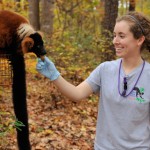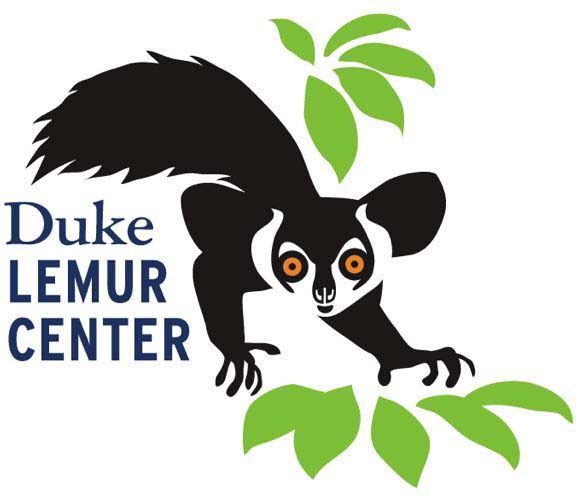November 26, 2013 — The Duke Lemur Center houses over 250 animals, but every individual is special. Here, we’ll take some time to help you get to know the stories behind some of our favorite residents. Get the scoop without the poop. In the following interview, technician Erin Shaw tells us how a very fortunate loris named Flea overcame astronomical odds to survive the illegal wildlife trade and find a happy ending at the Duke Lemur Center: (Interview by Pat Massard)
She was purchased at an antiques flea market. All of our pygmy slow lorises are named after insects, so the name fit both her history and the naming theme.
It is extremely rare for an accredited zoo or an expert facility such as the Duke Lemur Center to take in animals from the pet trade. If the Duke Lemur Center is not an animal rescue, how did Flea end up here?
A Sarasota, FL, couple found Flea at an antiques flea market in 2001 or early 2002 while traveling in Houston, TX, and purchased her because they thought she was being abused. It is assumed that she was wild caught and illegally imported. The Florida Fish and Wildlife Conservation Commission received her from the private owners not long afterwards, as they did not have a permitted facility. In July 2002, Flea moved to the Lemur Conservation Foundation in Myakka City, FL. Flea went in June 2003 to the Audubon Zoological Gardens in New Orleans. In December 2003 Flea arrived at the DLC. Quite a journey!
What type of loris is Flea? Where are they found in the wild? Are they endangered?
Flea is a pygmy slow loris, Nycticebus pygmaeus. They are found in Vietnam, Laos, Cambodia, and Southern China and are classified as vulnerable by the Convention on International Trade in Endangered Species of Wild Fauna and Flora (CITES) and the International Union for Conservation of Nature (IUCN).
How old is Flea?
Her estimated birth year is 1997.
It’s common in the pet trade to cut loris’ teeth with nail clippers or pull them out with pliers. Since Flea came from the pet trade, were her teeth removed?
She still has her teeth.
How would you describe her personality?
She is pretty shy and often found hiding under fleece or under her favorite paper bag in her room.
Any quirks or funny things she does?
She likes to climb to the very end of the bamboo stalks I put in her room and can stretch her body to reach places that I never would have imagined that she could access. Lorises have very strong limbs, and she must stretch out her body in a Superman pose to reach shelves/other branches.
Does she have a favorite food?
She very much enjoys her mealworms!
What’s your favorite thing about working with Flea?
It’s always interesting to try to find her and discover the new places she has explored.
Lorises are awfully cute. Do they make good pets?
Lorises are wild animals and yet the illegal pet trade, along with habitat destruction, is causing them to go extinct. They are the only known venomous primate and are nocturnal, found moving high above the ground at night. Housing them properly as a pet would be very difficult, as would providing them with the proper diet and veterinary care. Handling a loris can be also very stressful to the animal and being exposed to daytime lights can also be a big stressor. The animal markets in Southeast Asia that receive and sell the lorises keep them in terrible conditions and many do not survive long as a result. The Little Fireface Project has great information on loris conservation and the fight against illegal sale and importation of lorises. Here is one of their videos that exposes the awful conditions of the illegal sale of lorises:
 Erin Shaw has worked as a technician at the Duke Lemur Center since 2012. Before becoming a lemur keeper she worked in environmental education in Maryland, and was a volunteer at the National Zoo in Washington, DC.
Erin Shaw has worked as a technician at the Duke Lemur Center since 2012. Before becoming a lemur keeper she worked in environmental education in Maryland, and was a volunteer at the National Zoo in Washington, DC.
 Pat Massard has been volunteering at the Duke Lemur Center in a number of capacities since 2011. When she’s not volunteering, she works in the Department of Molecular Genetics and Microbiology at Duke.
Pat Massard has been volunteering at the Duke Lemur Center in a number of capacities since 2011. When she’s not volunteering, she works in the Department of Molecular Genetics and Microbiology at Duke.


